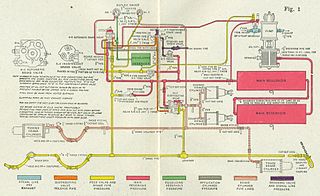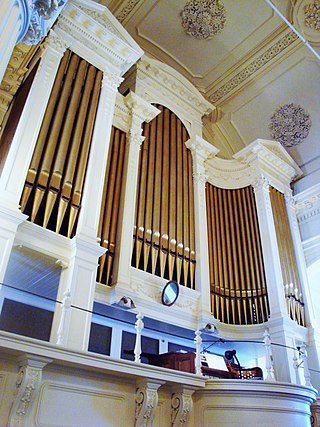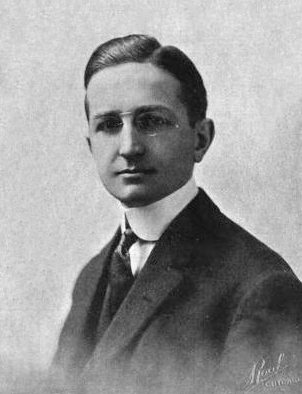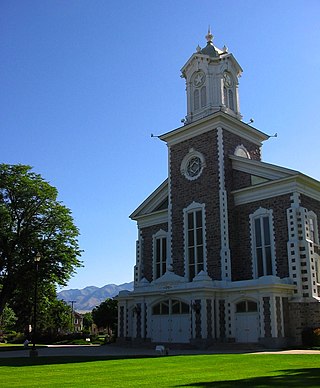Description
In any organ, each pipe has a valve located at its foot which responds to the organist's commands from the console's keyboard, pedalboard and stop controls. These valves are contained in windchests upon which the organ's pipework is set. Any type of apparatus that connects an organ's console with its windchest is referred to as its "action". An organ that utilizes tubular-pneumatic action is commonly called a "tubular-pneumatic organ".
It seems the first use of this action was in 1851, in Willis' Great Exhibition organ, though it was only very limited. It appears that the first organ using tubular-pneumatic action throughout was by T.C. Lewis at St Andrew's Hall, Glasgow, in 1877.
Operation
The operation of a tubular-pneumatic organ is accomplished by a change of air pressure within lead tubes of about 1⁄4 in (0.6 cm) inside diameter that connect the organ's console to its windchest. A separate tube is needed for each manual key, pedal key and stop control on the console. A large four manual organ can require over 300 individual tubes.
Two basic types of tubular-pneumatic actions were used: the "pressure" system and the more popular "exhaust" system. Both use three major components for each key and stop: a valve (within the console), a pneumatic motor, commonly called a 'pneumatic' (within the windchest), and a lead tube that connects them.
In the pressure system, the air in the tube and the pneumatic are normally at atmospheric pressure. Depressing a key increases the pressure in the tube, inflating the pneumatic, which opens the pipe's valve.
In the exhaust system, the pneumatic and tube normally contain windchest pressure. Depressing a key lets this pressure exhaust, which collapses the pneumatic and opens the pipe's valve.
Advantages and disadvantages
The advantages of the tubular-pneumatic action over the mechanical tracker action are a lightness of touch that does not change when couplers are used, and the flexibility of console location. Although the former was a great improvement over the tracker organ, the console location was still limited to around 50 ft (20 m) from the pipework.
While some considered the tubular-pneumatic action to be a great achievement in organ building, others thought just the opposite. Sir John Stainer, organist at St. Paul's, called it a "triumph of mechanical skill", while the eminent English organist W. T. Best called it "a complete failure; you cannot play a triplet on the Trumpet, and I consider it the most damnnable invention ever placed inside an organ". [3]
The major disadvantage of tubular-pneumatic action is its sluggish response. This becomes more prevalent as the distance between the console and the pipework is increased. In organs whose divisions are located at various distances from the console, this slow response causes an undesirable time lag between the speech of the divisions.
Another disadvantage over a tracker action organ is a lack of "feel" and control of attack by the organist, a trait that is present in all non-tracker action organs.
Decline of usage
With the application of electric power to pipe organ action, the use of tubular-pneumatic action quickly declined. An organ with electro-pneumatic action or direct electric action has the lightness of touch of a tubular-pneumatic organ, but a faster response, and the console can be in any remote location. The console can also be movable, with only a cable connecting it to the rest of the organ.
By the 1920s, tubular-pneumatic organs were rarely built.
Electro-pneumatic chests, however, frequently have sealed wood channels (tubes) in their wooden structural elements and bottom boards, usually consisting of wind channels running between the pipe valve and the primary with its electromagnets. Organ builders harnessed the difference in air pressures inside and outside the organ to do heavier work, taking the weak force of an electromagnet and multiplying its effect pneumatically to pull open pipe valves.

The pipe organ is a musical instrument that produces sound by driving pressurised air through the organ pipes selected from a keyboard. Because each pipe produces a single pitch, the pipes are provided in sets called ranks, each of which has a common timbre and volume throughout the keyboard compass. Most organs have many ranks of pipes of differing pitch, timbre, and volume that the player can employ singly or in combination through the use of controls called stops.

A railway air brake is a railway brake power braking system with compressed air as the operating medium. Modern trains rely upon a fail-safe air brake system that is based upon a design patented by George Westinghouse on April 13, 1869. The Westinghouse Air Brake Company was subsequently organized to manufacture and sell Westinghouse's invention. In various forms, it has been nearly universally adopted.

Pneumatics is a branch of engineering that makes use of gas or pressurized air.

Æolian-Skinner Organ Company, Inc. of Boston, Massachusetts was an American builder of a large number of pipe organs from its inception as the Skinner Organ Company in 1901 until its closure in 1972. Key figures were Ernest M. Skinner (1866–1960), Arthur Hudson Marks (1875–1939), Joseph Silver Whiteford (1921-1978), and G. Donald Harrison (1889–1956). The company was formed from the merger of the Skinner Organ Company and the pipe organ division of the Æolian Company in 1932.

In automotive engineering, an exhaust manifold collects the exhaust gases from multiple cylinders into one pipe. The word manifold comes from the Old English word manigfeald and refers to the folding together of multiple inputs and outputs.

Main components found on a typical steam locomotive include:

A theatre organ is a type of pipe organ developed to accompany silent films, from the 1900s to the 1920s.

Ernest Martin Skinner was an American pipe organ builder. His electro-pneumatic switching systems advanced the technology of organ building in the first part of the 20th century.
A relay valve is an air-operated valve typically used in air brake systems to remotely control the brakes at the rear of a heavy truck or semi-trailer in a tractor-trailer combination. Relay valves are necessary in heavy trucks in order to speed-up rear-brake application and release, since air takes longer to travel to the rear of the vehicle than the front of the vehicle, where the front service brakes, foot-valve, parking-control valve, and trailer-supply valve are located.
An air line is a tube, or hose, that contains and carries a compressed air supply. In industrial usage, this may be used to inflate car or bicycle tyres or power tools worked by compressed air, for breathing apparatus in hazardous environments and to operate many other pneumatic systems.

Tracker action is a term used in reference to pipe organs and steam calliopes to indicate a mechanical linkage between keys or pedals pressed by the organist and the valve that allows air to flow into pipe(s) of the corresponding note. This is in contrast to "direct electric action" and "electro-pneumatic action", which connect the key to the valve through an electrical link or an electrically assisted pneumatic system respectively, or "tubular-pneumatic action" which utilizes a change of pressure within lead tubing which connects the key to the valve pneumatic.
The electro-pneumatic action is a control system by the mean of air pressure for pipe organs, whereby air pressure, controlled by an electric current and operated by the keys of an organ console, opens and closes valves within wind chests, allowing the pipes to speak. This system also allows the console to be physically detached from the organ itself. The only connection was via an electrical cable from the console to the relay, with some early organ consoles utilizing a separate wind supply to operate combination pistons.
Registration is the technique of choosing and combining the stops of a pipe organ in order to produce a particular sound. Registration can also refer to a particular combination of stops, which may be recalled through combination action. The registration chosen for a particular piece will be determined by a number of factors, including the composer's indications, the time and place in which the piece was composed, the organ the piece is played upon, and the acoustic environment within which the organ resides.
Direct electric action is a systems used in pipe organs to control the flow of air (wind) into the organ's pipes when the corresponding keys or pedals are depressed. In direct electric action, the valves beneath the pipes are opened directly by electro-magnet solenoids, while with electro-pneumatic action, the electro-magnet's action admits air into a pneumatic or small bellows which in turn operates the pipe's valve.

The Logan Tabernacle is a tabernacle of the Church of Jesus Christ of Latter-day Saints and is located in Logan, Cache County, Utah. It is used regularly for church meetings, most often semi-annual stake conferences, seminary graduations, musical concerts, and lectures. The tabernacle welcomes visitors and is open for tours each summer from June to September. It is the site of many local celebrations, including the city's annual Summerfest Arts Faire held each June on the tabernacle grounds.

All Saints Church, Cheltenham, is a Grade I listed parish church in the Church of England in Cheltenham.

Casavant Frères Ltée. Opus 1841 is a pipe organ built by the famous Casavant Frères of Saint-Hyacinthe, Quebec. The organ was first completed in 1911 as Casavant Brothers - Opus 452 for St. Andrew's Presbyterian Church at 40 Bentinck Street, Sydney, Nova Scotia, Canada. St. Andrew's later became St. Andrew's United Church and is now the Highland Arts Theatre.

The organ of the Dorpskerk in Noordbroek in the Dutch province of Groningen was first built in 1696 by Arp Schnitger. Today it has 24 stops over two manuals and pedal. The case and the disposition are largely preserved as they were in 1809.

The west gallery organ in the Aa-kerk in Groningen was built by Arp Schnitger in 1699–1702. Originally built for the Academiekerk in Groningen it was moved to the Aa-kerk in 1815. Today it has 40 stops on three manuals and pedal, and is a monument of European significance.













